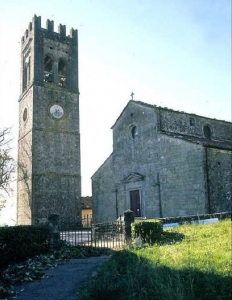
Information
Foundation:
IX century
District/Location:
Bagni di Lucca, Controne
District:
Mediavalle


First documented in the 9th century and Mother Church of the Controne area in the 10th century, the Parish Church of Controne served numerous surrounding communities, some of which went on to have their own church, while others, although well-established even up to modern times, continued to use their oratory. This large church, with a central nave and two side aisles, and a wealth of 17th century altars, still preserves its old medieval façade, above the present day apse.
Località Pieve di Controne, 55022 Bagni di Lucca LU
Documented as early as the 9th century, the church by the title S. Stefano results as obtaining the status of Parish Church in the 10th century, after having gained independence from the Parish Church of S. Giulia. In fact, in 913 this latter church results as dependent on that of S. Stefano, which, having become a Parish Church had assumed the title of S. Giovanni Battista. This Parish Church was destined to prevail for almost two centuries as the centre of the Controne area, a vast territory that already resulted as an administrative unit in the Lombard period, and was later owned by the heirs of viscount Fraolmo, progenitor of the Aristocracy of Corvara. The castle that overlooked the parish Church probably dates to this period. The church underwent alterations in the 14th century, including the inversion of its orientation, due to a landslide that had obstructed access to the façade. For this reason the medieval apse was demolished and reused in the façade, while a new apse was adjoined to the original façade of which remains the upper part with blind arches with an overlaying lozenge decoration which would suggest a date of around the 11th century. A new series of renovation works, above all on the ceilings, were carried out in the 19th century by Giuseppe Pardini, also responsible for the arrangement of the presbyterial area, which was then decorated at the start of the 20th century by Michele Marcucci. The church also conserves some important original interior furnishings. The 17th century carved wooden altars can still be seen (except that of the marble Crucifix remade in 1831 after being damaged by lightening); at the first on the right there is a wooden statue of Saint Antonio abate, and near the high-altar a 17th century version of the Holy Face. The marble altar was bought from the Church of S. Andrea in Lucca, in 1791. The church also has a valuable group of 17th century processional insignias of confraternities. Of the dependent oratories, those of Guzzano, Gombereto and Vetteglia are noteworthy for their wealth of interior furnishings, now housed in the Parish Church for security reasons.
Scopri altre attrazioni vicino a Saint John the Baptist - Parish Church of Controne
See allYou may also like..
See allFind more
0











